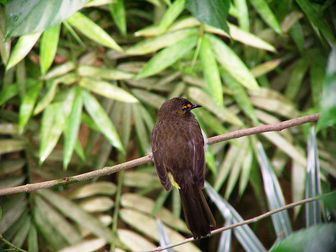Orange-spotted Bulbul
Its natural habitats are subtropical or tropical moist lowland forests and subtropical or tropical moist montanes.

Original source: Flickr
Author: Charles LamPermission(Reusing this file)This image, which was originally posted to Flickr.com, was uploaded to Commons using Flickr upload bot on 16:50, 17 December 2007 (UTC) by Ltshears (talk). On that date it was licensed under the license below. This file is licensed under the Creative Commons Attribution-Share Alike 2.0 Generic license.You are free:to share – to copy, distribute and transmit the work
The Orange-spotted Bulbul is classified as Least Concern. Does not qualify for a more at risk category. Widespread and abundant taxa are included in this category.
The Orange-spotted Bulbul (Pycnonotus bimaculatus) is a species of songbird in the Pycnonotidae family. It is endemic to Indonesia. Its natural habitats are subtropical or tropical moist lowland forests and subtropical or tropical moist montanes. References - * BirdLife International 2004. Pycnonotus bimaculatus. 2006 IUCN Red List of Threatened Species. Downloaded on 24 July 2007. Stub icon This Pycnonotidae-related article is a stub. More
The Orange-spotted Bulbul (Pycnonotus bimaculatus) is endemic to Indonesia. It can be found in subtropical or tropical moist lowland forest areas and subtropical or tropical moist montanes. - Photo, Video and/or Article contributions are welcome! Please click here for info The Avianweb strives to maintain accurate and up-to-date information; however, mistakes do happen. If you would like to correct or update any of the information, please send us an e-mail. More

Original source: Kilom691
Author: Kilom691
Permission: Some rights reserved
Family : Pycnonotidae
Genus : Pycnonotus
Species : bimaculatus
Authority : (Horsfield, 1821)

